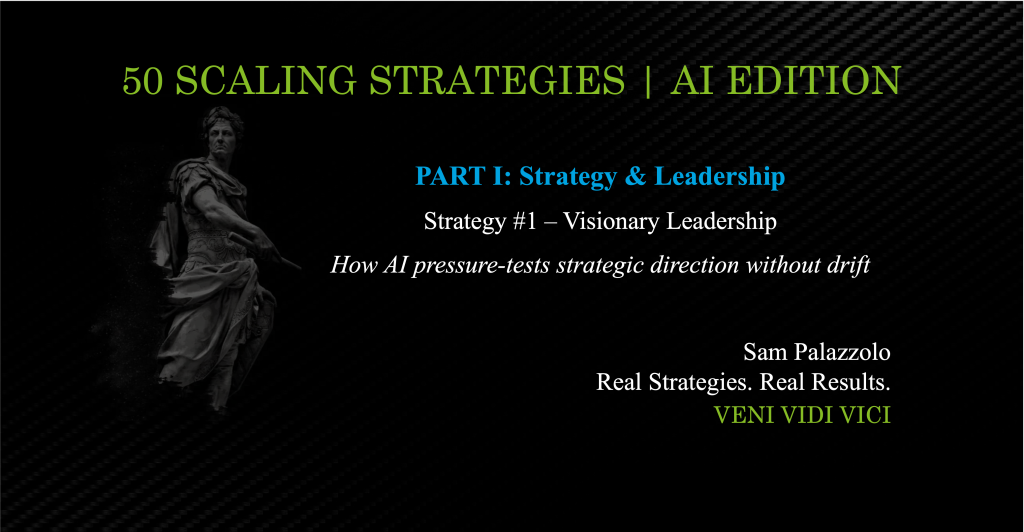Vision is easy to announce and hard to operationalize. Most leadership teams overestimate their clarity and underestimate the friction created by ambiguity. As organizations scale, a poorly engineered vision doesn’t just create confusion—it destroys execution speed, profitability, and team trust.
Vision isn’t a slogan. It isn’t a pitch deck slide. It isn’t an aspiration.
Vision is an operating system. Without a structure to enforce it, it collapses inside the day-to-day pressure of growth.
I’ve seen this firsthand working with founders and CEOs across industries—scaling from $1M to $10M, $10M to $50M, and into $500M+ environments. The fastest-growing companies do not have more ambition than their competitors. They have better structural discipline around direction. And now, AI has changed the game. Leaders can architect, pressure-test, and enforce vision faster than ever—if they know how to use it.
Why Most Visions Fail
The corporate world is filled with vision statements that sound impressive but lack operational consequence. The failure isn’t philosophical—it’s mechanical. Here’s why most visions collapse in execution:
- No resource enforcement – Teams hear “priorities” but watch time, budget, and people scattered across unrelated initiatives.
- Competing interpretations – Everyone thinks they are aligned, yet every department executes a different playbook.
- Strategy gets lost in motion – Teams ship work, but little of it actually advances the long-term direction.
- Leadership drift – Decisions are made without a consistent strategic filter, eroding momentum.
- Execution outpaces direction – Growth slows because operating systems fail to mature as complexity increases.
The result? Growth stalls. Morale dips. Good people leave. Leadership blames “execution,” but the truth is simpler: you can’t execute a vision that isn’t structurally defined.
Vision Must Be Built for Execution
High-performing companies engineer vision like a system—something that drives decisions, sequencing, and accountability. A real vision must answer three questions:
- Where are we going? (Strategic destination)
- Why this path and not others? (Strategic focus)
- How will we enforce direction consistently? (Strategic control)
This isn’t motivational thinking—it’s operational clarity. Leaders must shift from vision statements to vision systems.
The Vision Operating System
This is the same framework I install inside growth-stage organizations during a Scale Sprint engagement:
1. Define Future Reality With Precision
Most visions are constrained by today’s state. Instead, define the required future state:
- Which customers will you win three years from now?
- What transformation will you deliver that competitors cannot?
- What category will you dominate—and why?
This clarity forces identity and market ambition into the center of strategic planning.
2. Establish Strategic Non-Negotiables
A vision without boundaries invites chaos. Define what you will not do:
- One ICP until $50M revenue
- No custom deals under $250K ACV
- No feature development without monetization logic
- No roadmap changes outside a strategic review
Discipline creates acceleration. These constraints eliminate noise and preserve momentum.
3. Convert Vision Into Execution Architecture
Direction must translate into an operating cadence:
- Vision → Strategic Pillars → 90-Day Programs → Weekly KPIs
- Ownership tied to executives—not committees
- Decisions governed by a unified prioritization model
Vision is enforced not in meetings—but in management systems.
How AI Strengthens Vision
This is the AI Edition for a reason—AI can now pressure-test, clarify, and accelerate strategic direction faster than any offsite or planning cycle. Here’s how:
- AI stress-tests strategic logic – It can identify contradictions, weak assumptions, and market blind spots instantly.
- AI models multiple growth paths – Leaders can compare and simulate competing strategic directions to minimize risk.
- AI prevents drift – By embedding AI into operating cadences, teams maintain alignment through consistent strategic interpretation.
- AI improves decision velocity – Leaders can evaluate resource allocation scenarios in minutes, not weeks.
AI does not replace leadership. It eliminates strategic fog.
Real-World Example
A $20M ARR founder-led company approached me with a familiar issue: a “vision” that sounded compelling but was impossible to execute. They had five ICPs, three pricing models, and inconsistent go-to-market motions across regions.
We rebuilt their Vision Operating System in three steps:
- Committed to a dominant ICP and cut three markets
- Aligned product roadmap to monetization tiers
- Shifted messaging to category leadership narrative
Then we embedded AI into their weekly leadership cadence:
- AI pulse reports tied activity back to vision pillars
- AI flagged resource allocation misalignment early
- Leadership decisions became faster, cleaner, and more consistent
Result: $13M in new ARR in 8 months and zero missed quarters for the first time in company history. Vision didn’t change who they were. It made them unbeatable.
The Leadership Lesson
You do not need a new vision. You need executional vision—the kind that survives contact with reality. The kind that drives behavior when no one is watching. The kind that AI can enforce when pressure rises.
If your strategy does not show up in how people operate, you do not have a strategy. You have a speech.
Real Strategies. Real Results.
Winning companies don’t drift into the future—they build it by design. And design requires a disciplined operating system supported by AI, strategic clarity, and leadership enforcement.
This is the path forward.
Sam Palazzolo
Real Strategies. Real Results.
PS – Subscribe to the Business Scaling Newsletter for weekly operator frameworks and AI strategy tools that drive execution.
